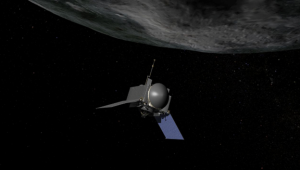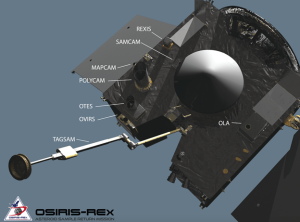OSIRIS-REx

Source: NASA
MISSION
The Origins-Spectral Interpretation-Resource Identification-Security-Regolith Explorer, or OSIRIS-REx, is a NASA mission in which a spacecraft travels to a near-Earth asteroid (NEA), Bennu. Asteroids, like Bennu, may provide necessary natural resources, such as metals, water, and organics for future economic development and space exploration.[1] The mission, launched September 8, 2016, is the first U.S. mission to return samples from an asteroid to Earth. OSIRIS-REx arrived at Bennu in December 2018.[2] OSIRIS-REx is the third mission in NASA's New Frontiers Program.[3]
EXPLORATION ENVIRONMENT
Bennu is a carbonaceous asteroid with the potential to provide information about the early history of the solar system within its regolith. It is possible Bennu contains the molecular precursors to the Earth’s oceans and origin of life.[4] The examination of Bennu’s chemical and physical properties will be essential for a potential mitigation mission in the future, as there is a relatively high probability of Bennu colliding with Earth in the late 22nd century.[5] As of November 2021, there is a 1 in 1750 chance of collision.[6]
MISSION OBJECTIVES
OSIRIS-REx’s key mission objectives include:
- “Return and analyze a sample of Bennu’s surface
- Map the asteroid
- Document the sample site
- Measure the orbit deviation caused by non-gravitational forces (the Yarkovsky effect)
- Compare observations at the asteroid to ground-based observations”[7]
SPACECRAFT
The OSIRIS-REx spacecraft was built by Lockheed Martin Space Systems.[8]
- “Length: 25 ft (6.2 m) with solar panels deployed
- Width: 8 ft (2.4 m) x 8 ft (2.4 m)
- Height: 33 ft (3.2 m)
- TAGSAM Length: 11 ft (3.4 m)
- TAGSAM Head Width: 12 in (30.5 cm) diameter
- Dry Mass (unfueled): 1,940 lbs (880 kg)
- Wet Mass (fueled): 4,650 lbs (2,110 kg)
- Power: Two solar panels totaling 91 ft² (8.5 m²) generate between 1,226 and 3,000 watts, depending on the spacecraft’s distance from the Sun.
- Payload: Five science instruments, the TAGSAM, and the SRC allow the spacecraft to gather data, collect a sample, and safely return it to Earth.”[9]
INSTRUMENTS
OSIRIS-REx is outfitted with five instruments for remote sensing or scanning of the surface of Bennu to map and establish what makes up the asteroid, including the distribution of elements, minerals, and organic material. It has an additional instrument for sample collection.[10]

Source: NASA/University of Arizona
- OSIRIS-REx Camera Suite (OCAMS) – the OSIRIS-REx camera suite is made up of the PolyCam, Map Cam, and SamCam which are responsible for global image mapping of Bennu’s surface, as well as, comprehensive photos of selected and potential sample sites.[11]
- OSIRIS-REx Laser Altimeter (OLA) – during the mission, the LIDAR (Light Detection and Ranging) instrument contributed high-resolution topographical information about Bennu.[12]
- OSIRIS-REx Visible and IR Spectrometer (OVIRS) – OVIRS was used to measure visible and infrared light from Bennu. The spectral maps OVIRS provided will determine organic and mineral material globally and assembled local spectral data for potential sample sites.[13]
- OSIRIS-REx Thermal Emission Spectrometer (OTES)– OTES assembled infrared (from 5.71–100 μ m) spectral data from Bennu. This data lets scientists determine temperature distribution and mineral composition of Bennu, which is used for local candidate sample-site areas and global maps.[14]
- REgolith X-ray Imaging Spectrometer (REXIS) – REXIS is a telescope that imaged the X-ray fluorescence line emission. This made mapping for elements on Bennu’s surface possible.[15]
- Touch-And-Go Sample Acquisition Mechanism (TAGSAM) – TAGSAM is a sampler head and articulated arm. The surface regolith was transmitted into the sampler’s chamber with a burst of pure nitrogen gas emitted after the sampler head contacted the surface of Bennu.[16]
TEAM
The OSIRIS-REx team is made up of engineers, veteran scientists, managers, students, and those starting careers.[17] The mission's principal investigator is Dr. Dante Lauretta from the University of Arizona. The mission’s science team and science observation and processing are led by the University of Arizona. Overall mission management, systems engineering and safety and mission assurance for OSIRIS-Rex is provided by NASA's Goddard Space Flight Center in Greenbelt, Maryland. In addition to designing and building the spacecraft, Lockheed Martin Space Systems in Denver provide flight operations. Navigation of the OSIRIS-REx spacecraft is the responsibility of Goddard and KinetX Aerospace. Collaborators outside the U.S. also contribute to this mission. For a full list of team members and affiliations, click here.[18]
BUDGET
Funding for OSIRIS-REx is supported through NASA’s budget for planetary science under the New Frontiers Other Missions and Data Analysis account. A snapshot of the FY 2023 budget request is below. The snapshot also illustrates the requested budget from FY 2022 and projections beyond 2023.[19]

Source: NASA
MISSION TIMELINE
OSIRIS-REx was launched on September 8, 2016 in Cape Canaveral, Florida. Its solar arrays were deployed almost an hour after launch, following a boost by the Centaur upper stage. OSIRIS-REx reached Bennu on December 3, 2018. The mission team spent a year deciding on a safe sample collection site as OSIRIS-REx conducted a thorough mapping of the asteroid.[20]
On October 20, 2020, dust and pebbles from Bennu were collected successfully from the sample site, “Nightingale,” after OSIRIS-REx overcame the challenging rocky terrain and hazardous boulders that make up Bennu’s surface. April 7, 2021, marked OSIRIS-REx’s last flyover of Bennu and the return journey to Earth began on May 10, 2021.[21]
OSIRIS-REx should reach Earth on September 24, 2023, where the sample capsule will be released to the Utah Test and Training Range for study.[22]
RECENT NEWS
In October 2020, NASA reported the OSIRIS-REx spacecraft stowed the Sample Return Capsule (SRC) containing a sample from asteroid Bennu. Stowing the sample required two uninterrupted days to examine telemetry and images from previous steps before moving on to the next one. Due to the 205-million-mile distance between Earth and the spacecraft, there was over an 18.5-minute time delay for signals to and from both parties. On October 28, 2020, the sample was ready for the spacecraft’s return to Earth.[23]
Updated November 2022 by Jackie Johnson

Comments are closed.